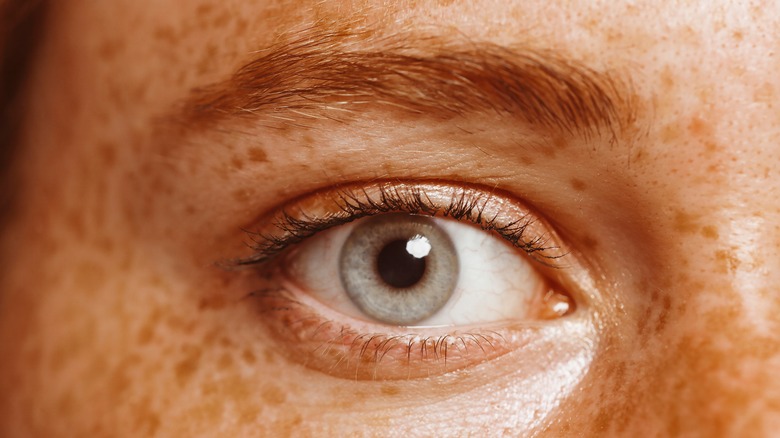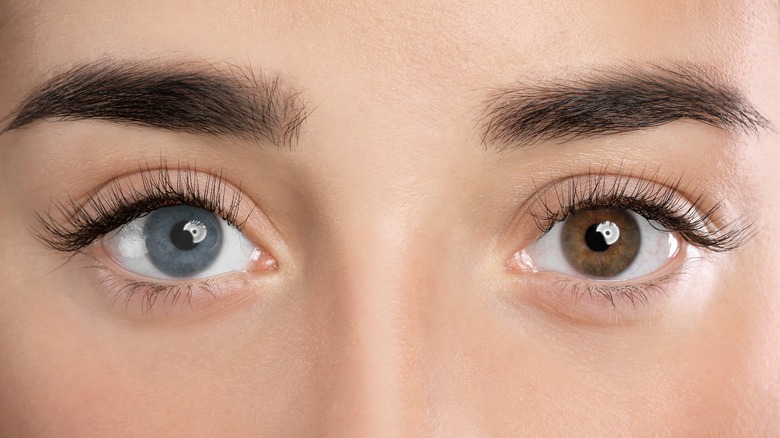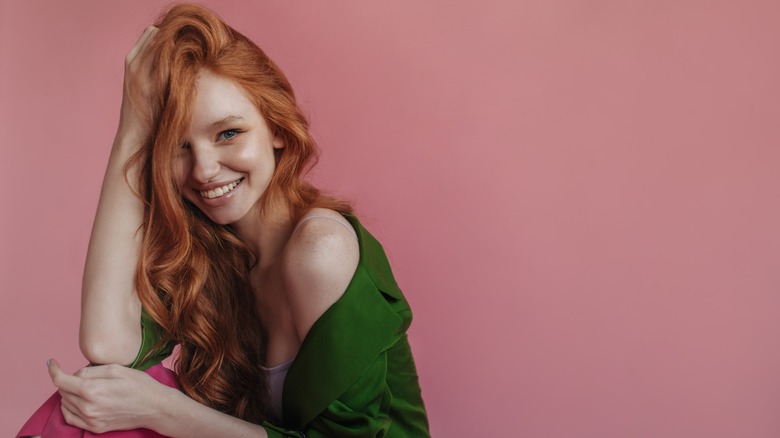Why Having Blue Eyes With Red Hair Is So Rare
In 2008 South East Queensland Australia, a young redheaded girl and her twin enrolled in a scientific study. When the researchers tested their DNA, they made a brand new discovery in human genetics — the DNA of one of the little girls told scientists the default hair color for all people is red (via Human Mutation).
It seems strange that the default color should be so rare. Depending on the population, only 1% to 2% of people have red hair (via British Medical Journal). Genetics is the main culprit responsible for both hair and eye color (via Twin Research and Human Genetics). Your genetics has roughly 61% to 100% to do with hair color and 98% with eye color (via Biological Psychology). Most people would agree that lighter-colored eyes are associated with red hair (via British Medical Journal), and research backs this up by confirming that yellow and red-haired people are likely to have blue-gray eyes, and brown-haired people brown eyes.
With both red hair and blue eye traits being rare worldwide, you might think it would be the rarest combination. But the genetics of eye color is more complicated than recessive or dominant traits (via Pigment Cell & Melanoma Research). The complex nature of genes and protein interactions is keeping the secrets behind these traits all knotted up.
The mechanics behind being a redhead
We owe the color of our hair and skin to cells called melanocytes and the pigment they produce. These cells all make the protein responsible for red hair: melanocortin-1 receptor, or MC1R (via Human Mutation). Different versions of the protein perform their responsibilities at various levels.
Versions of the MC1R genes responsible for red hair are common in the northern hemisphere and Northern European populations (via Annual Review of Genetics). In caucasians, some versions of MC1R are associated with red hair, fair skin, skin cancer risk, and freckles. If you received a red hair version of the MC1R from both parents, you likely have red hair. Notably, the red-haired Australian twin didn't have any of the known variations of MC1R. In fact, the MC1R protein was gone. She was the first example found of someone with no working MC1R protein. Given that MC1R is the primary gene associated with the production of the red pigment, the presence of red hair in the twin — even in the gene's absence — proves that the default hair color for humans is red.
The genetics of eye color
According to researchers in Pigment Cell & Melanoma Research, the iris is "probably the most complex tissue structure that is readily available on the outside of the human body." Its tissue "forms complex patterns that contain many distinct features," and for this reason, banks, governments, and other security industries have begun to use eyes for automatic personal identification (via Passport Info). The iris has multiple layers, and pigments at these different layers are part of what gives the iris its color. For example, brown eyes have lots of melanocytes and thus higher amounts of melanin than blue eyes. Thickness also affects color — it determines if you're sporting blue-gray, green, or hazel eyes.
Is the combination of red hair and blue eyes in one person really the rarest? Some say that it's as simple as them both being recessive genes and having a low prevalence in the world population. But the relationship between hair color and eye color is complex (via Twin Research and Human Genetics). There are numerous genes responsible for eye color, and some of these same genes mess with hair color gene expression, creating a thicket of overlapping variables that determine coloring (via Nature).
The rarest hair-eye combination might not be what you think
The science behind hair and eye color is as entangled as curly hair after a windstorm. While articles such as one in the University of Melbourne's Pursuit state that the lowest odds for any hair-eye color combinations is red hair and blue eyes at 0.17%, a scientific article verifying this number is difficult to find.
In a caucasian Netherlands population, where more redheads can be found for their study, researchers in Twin Research and Human Genetics found that 1.6% had the rare red hair and blue-gray eyes combo. However, the green-hazel eyes and red hair combination was lower at 0.4%, and red hair and brown eyes was the lowest prevalence at 0.3% of the study group. This shakes up the assumption that if both traits are recessive and at low prevalence, they're going to be the rarest in combination. However, further research is necessary because this study was limited by the lack of redheads — even in their 3,500-plus subject pool.
Given that red hair is the default hair color (via Human Mutation), it will be interesting to see what future research reveals about the rarity of red hair and blue eyes — and what other combinations are even rarer.



